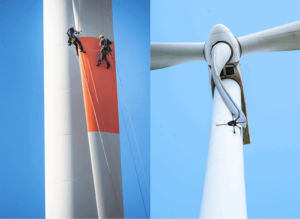Ensuring that each turbine’s Lightning Protection System (LPS) is intact is critical, and the industry standard IEC 61400-24 recommends routine testing of the entire lightning path — from blade tip receptor to ground.
But until recently, testing wind turbine LPS system’s required risky, time-consuming rope access and manual ohmmeter use. Some newer solutions involve heavy robotic systems with high-voltage test pulses, or signal-injection techniques that can suggest continuity but not quantify it. Now, there’s a smarter, more scalable option: Voliro T.

What’s the Difference Between Drone and Traditional LPS Inspection Tools for Wind Turbines?
Here’s a detailed comparison of the inspection tools used in both approaches:
| Component | Traditional Rope/Scaffold Method | Voliro T Drone-Based Inspection |
| Measurement Device | Handheld ohmmeter (2-wire or 4-wire if done properly) | Certified 4-wire micro-ohmmeter (Mostec VG-BAT-150) at ground level |
| Measurement Current | Varies (often low-current, not standardized in field use) | Fixed 0.3 A, per IEC 61400-24 recommendations |
| Measurement Method | Often 2-point continuity test (prone to contact resistance errors) | 4-point Kelvin measurement eliminates lead/contact resistance |
| Probe/Contact | Technician manually touches each receptor with leads | Drone with needle probe payload applies stable contact with ~2 kg force |
| Data Logging | Manual notes, photos, or handheld reader memory (not always linked to receptor) | Digital data reporting tool logged onboard drone and ohmmeter, receptor-specific. Measurements can be verified in real-time by the operator on the control tablets. |
| Grounding Reference | Typically turbine base or hub (manual setup needed) | Voliro system integrates tether with grounding cable and signal return |
| Cable Management | Loose handheld leads or temporary routing by technician | Automated Cable Management System (CMS) keeps drone tether tensioned |
| Environmental Readiness | Sensitive to operator error, fatigue, wind or access issues | Designed for outdoor use, contact in wind up to 8 m/s, 12 m/s in free flight |
How does drone-based full-loop LPS testing works?
Full-loop testing means verifying the entire LPS circuit: from each blade’s lightning receptor, down through the conductor, across internal junctions (e.g. at the hub or nacelle), and ultimately to the grounding system. This ensures the path a lightning strike would follow is continuous and low-resistance — not just theoretically intact, but electrically sound.
The Voliro T system enables this with:
- A drone-mounted needle probe that establishes electrical contact with the receptor
- A tethered micro-ohmmeter at the turbine base
- 4-wire resistance measurements for milliohm precision
In most cases, inspections take only 20–30 minutes per turbine, with no climbing, no nacelle access, and minimal turbine downtime.



